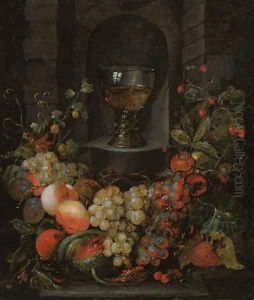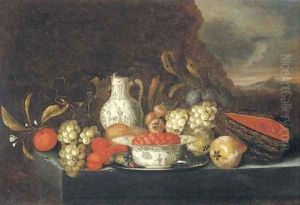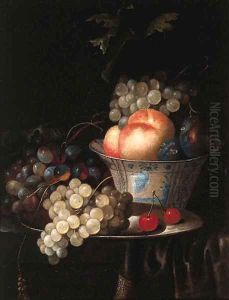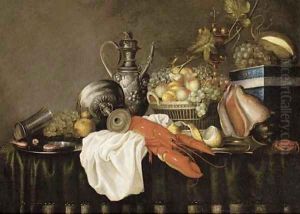Jan Pauwel The Elder Gillemans Paintings
Jan Pauwel Gillemans the Elder was a distinguished Flemish Baroque painter known for his still life compositions, particularly those featuring fruit. Born in Antwerp in 1618, Gillemans was a product of a vibrant period in Flemish art, which was characterized by a keen interest in naturalism and a meticulous attention to detail. He was a member of the Guild of Saint Luke in Antwerp, an institution that played a crucial role in the careers of artists in the region by regulating the art profession, providing artists with education and training, and organizing artistic commissions.
Gillemans' work is emblematic of the Baroque style, which emphasized dramatic lighting, rich colors, and intricate details to evoke a sense of awe and grandeur. His still lifes are particularly noted for their vibrant depiction of fruit, often arranged in opulent settings that reflect the wealth and sophistication of his patrons. These compositions not only showcase his technical skill and ability to render textures and surfaces with high realism but also reflect the Baroque era's fascination with the natural world and its desire to capture its transient beauty.
Throughout his career, Gillemans contributed to the development of the still life genre, which gained significant popularity in the 17th century. His paintings are characterized by a dynamic arrangement of objects, sophisticated use of light and shadow, and a deep understanding of color and form. These elements combine to create works that are visually striking and rich in symbolism, often reflecting themes of abundance, vanitas, and the fleeting nature of life.
Jan Pauwel Gillemans the Elder's legacy is preserved in numerous collections and museums around the world, where his works continue to be studied and admired for their beauty and historical significance. Despite the passage of centuries, his paintings remain a testament to the skill and creativity of Flemish Baroque artists, and his contributions to the still life genre continue to influence artists to this day. Gillemans passed away in Antwerp in 1675, leaving behind a body of work that continues to captivate and inspire.



